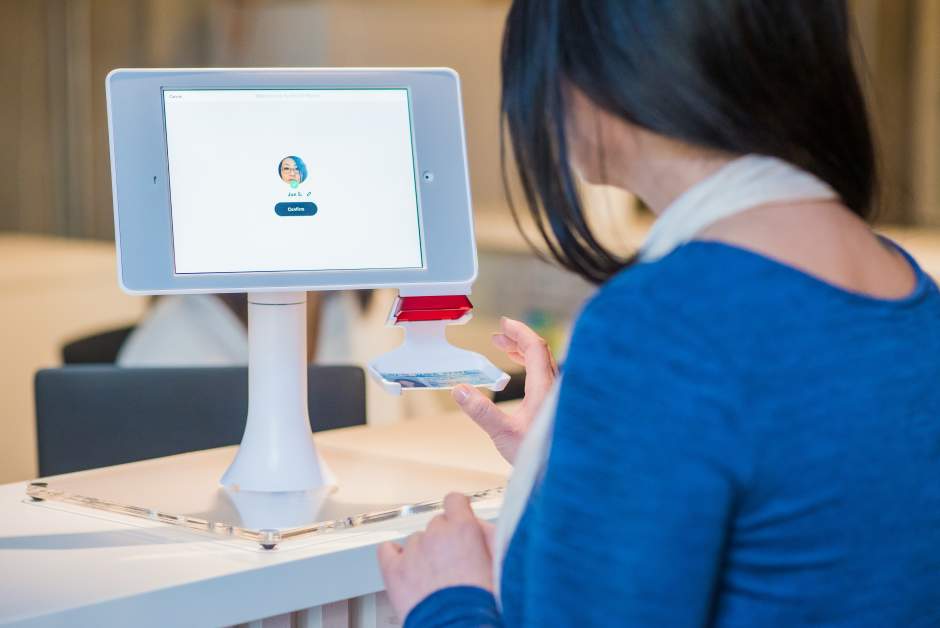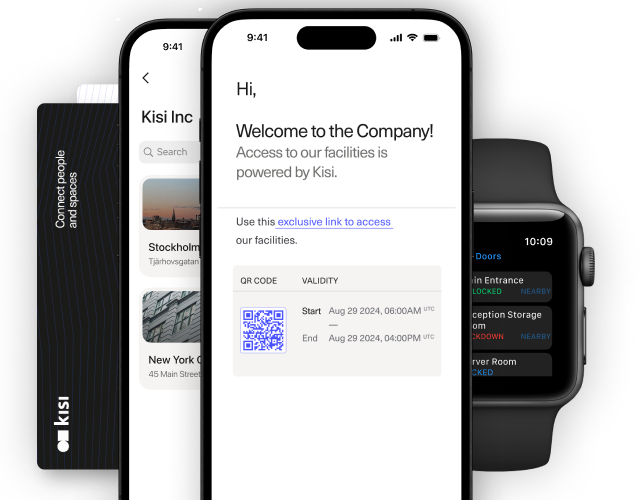Traditional check-in methods are often plagued with issues—long lines, slow identification verification, and messy handwritten logs, just to name a few. As a result, they’ve gained a reputation as being inefficient, inaccurate, and vulnerable to breaches.
Organizations that want to ensure the security of their people, property, and assets have a lot to gain from an updated visitor management system. A digital solution makes check-ins faster and safer while also giving a deeper look into activity occurring in and around your business.
This guide focuses on the core component of many of these systems: The visitor management kiosk. You’ll learn how this kind of kiosk functions, why it’s a good option, and how you can select the right option for your organization.
What is a visitor management kiosk? #
A visitor management kiosk is an automated system people can use to check in or out of a building, office, or other space. Most modern kiosks are tablets or touch-screen devices, which allow visitors to enter their personal information, scan their IDs, and print badges. A kiosk based visitor management system is an effective alternative to constantly staffing a reception desk during operating hours.

Key features of visitor kiosks #
Visitor management system kiosks vary in complexity and components, but most have the same basic functionalities. A typical kiosk usually has these capabilities:
- Self check-in: Kiosks are designed to allow visitors to manage their own check-in processes without support from a staff member.
- ID scanning: Many visitor kiosks allow visitors to scan an ID, such as a driver’s license, to confirm their identity and screen them against a database of individuals who aren’t allowed on the property.
- Badge printing: A kiosk can usually print a badge for the visitor to wear while on the premises.
- Information collection: Visitors enter important details into kiosks, including their contact information and the purpose of their visit.
- Real-time notifications: Most kiosks can trigger notifications to staff when a visitor arrives.
- Remote management: Business owners, property managers, and other employees can generally review information, track on-site activity, and update authorizations using cloud-based visitor management software.
These features are a powerful addition to your visitor management system and your overall security. They also go above and beyond what you can accomplish with most other check-in systems, especially handwritten sign-in logs.
How a visitor sign-in kiosk works #
One of the reasons visitor kiosks are so appealing is because they’re simple to use. Depending on your organization’s preferences and security requirements, users typically only have to complete a few tasks to check in for their visits.
Pre-arrival #
Visitor kiosk software is usually cloud-based, so it can pull information someone enters on a separate device. For example, a future visitor can pre-register using a page on your company’s website or a visitor kiosk app. During this process, they can enter basic details, including their name, phone number, email address, and reason for visiting. When they arrive at your physical location, they can skip registration and check in more quickly.
Keep in mind that pre-registration is optional—you can also require visitors to wait and enter their information when they arrive on-site. However, many organizations allow this step to occur prior to arrival because it saves time, streamlines the check-in process, and prevents long wait times.

Arrival #
When a visitor arrives at your building, they approach the kiosk and follow the instructions on the screen. If they didn’t pre-register, they’ll enter their personal information and indicate who they’re visiting.
In some cases, a visitor might receive a QR code before going to your office or building. Employees within your organization can send these codes in advance if they know someone will be coming by in the future. Rather than entering their details, visitors with QR codes scan them using a reader on the kiosk.
Identity verification #
If confirming the identities of visitors is important for your organization, the kiosk can also require the visitor to scan a driver’s license or another form of identification. For instance, visitor kiosks in schools can take data from a driver’s license and compare it against a list of registered sex offenders or banned individuals. Some systems also take a photo of the visitor to store for later reference and tracking.
Badge printing #
After gathering the visitor’s information and verifying their identity, the kiosk will automatically print a badge. Many systems allow you to customize what the badge includes, such as the visitor’s name, their picture, and the date of the visit. If you have notifications enabled, you’ll receive an alert as the badge prints, letting you know the visitor has arrived. With some systems, visitors also have to scan their badges to when exiting the property.
Benefits of visitor kiosk systems #
In 2024, the global visitor management system market was valued at $1.7 billion, and experts expect it to reach $5.7 billion over the next decade. This impressive growth is largely because of the many advantages visitor kiosks provide, from convenience to safety to data tracking.
Increased security #
Traditional check-in sheets are fast and easy, but they’re sorely lacking when it comes to security. They capture limited details and do little to prevent someone from entering with a false name or identification.
A visitor check-in kiosk, on the other hand, has advanced features that close these gaps. Many systems are capable of ID verification, signature collection, and photo captures, which significantly strengthen your security by preventing unauthorized or unsafe individuals from accessing your space.
Kiosks can also alert you to problems during the check-in process. For example, if someone who has threatened staff or caused property damage in the past attempts to check-in, the system can instantly alert management and security staff. This enables them to respond more quickly and resolve potential security incidents before they escalate.
Improved visitor experience #
Whether you work for a hospital, school, hotel, or business office, you want visitors to have a good impression of your organization when they arrive. When used properly, a visitor management kiosk paints your company in a positive light from that first interaction.
To meet and exceed visitor expectations, you need a management system that respects their time and privacy. With a kiosk, visitors don’t have to wait for a staff member to help them or enter their personal information multiple times. Instead, they can use a straightforward, self-service system that quickly collects, processes, and confirms their details and prints a badge. Notifications also make wait times shorter, ensuring the appropriate employee greets the visitor and addresses their needs.
Visitor tracking #
Manually collecting and analyzing visitor data is tedious and, if you have a high visitor volume, difficult to maintain over time. A visitor kiosk platform can automatically examine visitor data and provide insights you can use to make more informed decisions.
For example, a visitor management kiosk can highlight trends and patterns, helping you better understand these areas of your organization:
- Peak hours
- Staffing
- Resource allocation
- Space utilization
- Service offerings
- Wait times
- Customer and client loyalty
Visitor tracking is also critical to your business security, particularly when paired with access control and video surveillance systems. You’ll always know who is on site, how long they’ve been there, and why they’re visiting. If a security incident occurs on the premises, this information helps ensure everyone is safe and accounted for and supports future investigative efforts.
Cost savings #
Virtual receptionist kiosk software has an obvious upfront cost, but it can substantially reduce your spending over time. Implementing an automated system allows you to reduce front desk staffing and assign employees to more productive tasks. When your team members don’t have to stop what they’re doing to sign in a visitor or check on their status, they can accomplish their goals more efficiently.
A kiosk can also cut back on financial losses due to criminal activity, such as property damage and theft. For many organizations, particularly those in high-risk industries such as finance or healthcare, a visitor management kiosk also helps avoid expensive compliance violations. It assists in protecting private employee, customer, and client information and preventing serious legal and reputational damage.
How to choose a kiosk visitor management system #
Visitor management kiosks come in many variations. For example, some use wall-mounted tablets while others rely solely on apps. Selecting the specific hardware and software you want to use is the first step to picking a suitable visitor management system.
Making that choice often isn’t as easy as it sounds. In a rapidly evolving industry, you have a lot of options to sift through, and multiple systems might seem like a good fit. To help clarify your decision, ask and answer these questions about the systems you’re considering:
- User experience: Will the system guide visitors smoothly through check-in, or will they feel frustrated and overwhelmed? Test the system to see whether it’s user friendly for everyone or only for tech savvy visitors.
- Customization options: Can you tailor the system to your organization’s needs? Research whether the system will allow you to make registration changes, such as requiring visitors to sign special documents or disclaimers, and incorporate logos and graphics on printed badges.
- Scalability: Will it be difficult to adjust the system when you experience increased visitor traffic and introduce new features? Focus on future-proof solutions like Kisi that adapt to your organizational growth by accommodating higher visitor numbers and global locations and automatically pushing out software updates.
- Integrations: Is the kiosk compatible with existing technologies, including access control and security systems? Integrating these solutions makes your security more comprehensive and simplifies management processes.
- Data security features: What measures are in place to prevent data breaches and other security incidents related to the kiosk? A system with encryption, user authentication, and secure storage is essential to ensuring information entered into the system doesn’t fall into the wrong hands.
Evaluating these points based exclusively on what companies say about their products online and during sales meetings may not give you a full picture of what you’ll receive. On top of that research, try to get hands-on experience with the software, especially if they offer a free trial, read online reviews, and ask for recommendations from other members of your industry.

Enhance visitor management with Kisi #
Visitors are a welcome sight for most organizations because they’re a clear sign of interest and engagement in what your team is doing. However, the practical steps in handling visitors are usually less exciting, particularly if your company still relies on outdated, inefficient systems. Making the switch to a modernized visitor management kiosk makes visiting your site a breeze for everyone involved.
Kisi has long been committed to protecting your business, optimizing your operations, and making life easier for your team, and our visitor management system offers another way to meet those objectives. Reach out to learn more about our solution and how you can integrate it with access control and video surveillance. Better yet, schedule a demo so you can see firsthand what Kisi can do.


